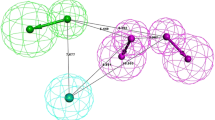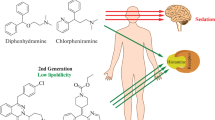Abstract
Asthma is an inflammatory disease of the lungs. Clinical studies suggest that eotaxin and chemokine receptor-3 (CCR3) play a primary role in the recruitment of eosinophils in allergic asthma. Development of novel and potent CCR3 antagonists could provide a novel mechanism for inhibition of this recruitment process, thereby preventing asthma. With the intention of designing new ligands with enhanced inhibitor potencies against CCR3, a 3D-QSAR CoMFA study was carried out on 41 4-benzylpiperidinealkylureas and amide derivatives. The best statistics of the developed CoMFA model were r 2 = 0.960, \( r_{cv}^2 = 0.589 \), n = 32 for the training set and \( r_{pred}^2 = 0.619 \), n = 9 for the test set. The generated 3D-QSAR contribution maps shed some light on the effects of the substitution pattern related to CCR3 antagonist activity.




Similar content being viewed by others
References
Gleich GJ, Adolphson CR (2000) The eosinophil and asthma. In: Busse WW, Holgate ST (eds) Asthma and rhinitis, 2nd edn. Blackwell, Oxford, pp 419–470
Gleich GJ (1990) The eosinophil and bronchial asthma: current understanding. J Allergy Clin Immunol 85:422–436
Griffiths-Johnson DA, Collins PD, Rossi AG, Jose PJ, Williams TJ (1993) The chemokine, eotaxin, activates guinea-pig eosinophils in vitro and causes their accumulation into the lung in vivo. Biochem Biophys Res Commun 197:1167–1172
Kampen GT, Stafford S, Adachi T, Jinquan T, Quan S, Grant JA, Skov PS, Poulsen LK, Alam R (2000) Eotaxin induces degranulation and chemotaxis of eosinophils through the activation of ERK2 and p38 mitogen-activated protein kinases. Blood 95:1911–1917
Murphy PM, Baggiolini M, Charo IF, Hebert CA, Horuk R, Matsushima K, Miller LH, Oppenheim JJ, Power CA (2000) International union of pharmacology. XXII nomenclature for chemokine receptors. Pharmacol Rev 52:145–176
Zlotnik A, Yoshie O (2000) Chemokines: a new classification system and their role in immunity. Immunity 12:121–127
Bertrand CP, Donath PD (2000) CCR3 blockade as a new therapy for asthma. Expert Opin Invest Drugs 9:43–52
Duchesnes CE, Murphy PM, Williams TJ, Pease JE (2006) Alanine scanning mutagenesis of the chemokine receptor CCR3 reveals distinct extracellular residues involved in recognition of the eotaxin family of chemokines. Mol Immunol 43:1221–1231
Wise EL, Duchesnes C, da Fonseca PCA, Allen RA, Williams TJ, Pease JE (2007) Small compound receptor agonists and antagonists of CCR3 provide insight into mechanisms of chemokine receptor activation. J Biol Chem 282:27935–27943
Berger EA, Murphy PM, Farber JM (1999) Chemokine receptors as HIV-1 coreceptors: roles in viral entry, tropism, and disease. Annu Rev Immunol 17:657–700
Alkhatib G, Berger EA, Murphy PM, Pease JE (1997) Determinants of HIV-1 coreceptor function on CC chemokine receptor 3, importance of both extracellular and transmembrane/cytoplasmic regions. J Biol Chem 272:20420–20426
Boehme SA, Sullivan SK, Crowe PD, Santos M, Conlon PJ, Sriramarao P, Bacon KB (1999) Activation of mitogen-activated protein kinase regulates eotaxin-induced eosinophil migration. J Immunol 163:1611–1618
El-Shazly A (2003) Basic concepts in eosinophil recruitment to sites of allergic inflammation: an in vitro model of the pathophysiology of late response in allergic rhinitis. Int Congr Ser 1240:1081–1086
Pease JE, Wang J, Ponath PD, Murphy PM (1998) The N-terminal extracellular segments of the chemokine receptors CCR1 and CCR3 are determinants for MIP-1alpha and eotaxin binding, respectively, but a second domain is essential for efficient receptor activation. J Biol Chem 273:19972–19976
Vedani A, Dobler M, Dollinger H, Hasselbach KM, Birke F, Lill MA (2005) Novel ligands for the chemokinereceptor-3 (CCR3):a receptor-modeling study based on 5D-QSAR. J Med Chem 48:1515–1527
Kubinyi H (2006) Special Publication. Royal Society of Chemistry 304:219–240
Awale M, Mohan CG (2008) Molecular docking guided 3D-QSAR CoMFA analysis of N-4-pyrimidinyl-1H-indazol-4-amine inhibitors of leukocyte-specific protein tyrosine kinase. J Mol Model 14:937–947
Awale M, Mohan CG (2008) 3D QSAR CoMFA analysis of C5 substituted pyrrolotriazines as HER2 (ErbB2) inhibitors. J Mol Graph Model 26:1169–1178
Garg D, Gandhi T, Mohan CG (2008) Exploring QSTR and toxicophore of hERG K+ channel blockers using GFA and HypoGen techniques. J Mol Graph Model 26:966–976
Wold S, Johansson A, Cochi M (1993) In: Kubinyi H (ed) 3D QSAR in drug design: theory, methods and applications. ESCOM, Lieden, pp 523–550
Wacker DA, Santella IJ, Gardner DS, Varnes JG, Estrella M, DeLucca GV, Ko SS, Tanabe K, Watson PS, Welch PK (2002) CCR3 antagonists: a potential new therapy for the treatment of asthma. Discovery and structure-activity relationships. Bioorg Med Chem Lett 12:1785–1789
Cramer RD III, Patterson DE, Bunce JD (1988) Effect of shape on binding of steroids to carrier proteins. J Am Chem Soc 110:5959–5967
SYBYL7.1, Tripos Inc, St Louis, MO
Clark M, Cramer RD, Van Opdenbosch N (1989) Validation of the general purpose tripos 5.2 force field. J Comput Chem 10:982–1012
Cramer RD, Bunce JD, Patterson DE, Frank IE (1988) Cross validation, bootstrapping and partial least squares compared with multiple regression in conventional QSAR studies. Quant Struct Act Relat 7:18–25
Acknowledgements
The authors are thankful to the Department of Pharmaceuticals, Govt. of India, for financial support. V.J. and A.P. gratefully acknowledge financial support received from the department in the form of a Junior Research Fellowship. S.G. is the recipient of a Senior Research Fellowship from the Council of Scientific and Industrial Research (New Delhi).
Author information
Authors and Affiliations
Corresponding author
Electronic supplementary material
Below is the link to the electronic supplementary material.
Figure S1
(DOC 213 kb)
Rights and permissions
About this article
Cite this article
Jain, V., Pandey, A., Gupta, S. et al. Ligand-based molecular design of 4-benzylpiperidinealkylureas and amides as CCR3 antagonists. J Mol Model 16, 669–676 (2010). https://doi.org/10.1007/s00894-009-0621-z
Received:
Accepted:
Published:
Issue Date:
DOI: https://doi.org/10.1007/s00894-009-0621-z




